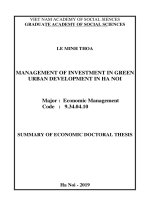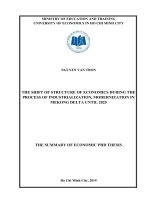Lecture Development economics - Lecture 13: Theories of economic development - 3
Bạn đang xem bản rút gọn của tài liệu. Xem và tải ngay bản đầy đủ của tài liệu tại đây (70.34 KB, 22 trang )
Theories of Economic
Development - 3
Lecture 13
Linear Stages Theory and Rostow's Stages of
Economic Growth
The theorists of 1950s and early 1960s viewed the
process of development as a series of successive
stages of economic growth through which all the
advanced nations of the world had passed. As all the
modern industrial nations of the world were once
undeveloped peasant agrarian economies.
Accordingly, their historical experience in transforming
their economies from poor agri. subsistence societies
to modern industrial giants had important lessons for
backward countries of Asia, Africa and Latin America.
In this respect, we discuss the Rostow's stages of
economic growth.
W.W. Rostow's Stages of Economic Growth:
W.W. Rostow was an American economist who
presented 'Stages of Growth' model of development.
According to Rostow,
the process whereby all the developed industrial
nations of the world transformed themselves from
backwardness to prosperity can be described in
terms of a series of stages.
These stages of economic growth are:
(1)Traditional society,
(2) Pre-conditions to take-off,
(3) Take-off,
(4) Drive to maturity,
(5) High mass consumption. They are discussed below:
(1) Traditional Society:
The traditional society is one whose production
functions are based up pre-Newton science and
technology. This unchanging technology places a
ceiling on productivity.
• In this society a higher proportion of resources is
devoted to agriculture.
• Man is valued on family basis, not on the basis of his
capabilities.
• Long Fatalism prevails in such society. The range of
possibilities for a grand children are the same what
they were for grand father.
• The society is ruled by those who owned or controlled
land. These landlords used to have a long chain of
servants and soldiers. This society was available
(2) Pre Conditions to Take Off:
It is a period of transition where the conditions for takeoff are developed.
Historically, it was due to invasion of advanced societies
which destroyed the culture of traditional society.
This paved the way for the emergence of new ideas. In
this way, when the new ideas develop people start
thinking about economic progress which could provide
a better life for the present and future generation.
Once the changes set in, they feed on themselves. It is
the education which broadens the mental out look of
the people, and it induces the people to accept new
challenges. In this way, the new entrepreneurs come
forward to take risks.
Due to establishment of financial institutions savings and
investment are mobilized in SOC. But still the society
is characterized by low productivity.
Still there is a need to build an effective national state
against the traditional land-lordism.
According to Rostow, the transition is a multidimensional phenomenon.
• A country with 75% of its population in agri. will have
to be shifted to industry, trade and commerce.
• The view to have more children will have to be
replaced by less children.
• The income will have to be shifted from the feudals to
those who will spend it on productive items.
• The man will be valued on the basis of his
Moreover, during this transitional period, the following
major changes will occur:
(i) Crucial Role By Agriculture: For the sake of
transition the self-sufficiency in agri. is required. Such
self-sufficiency is justified on the following grounds:
(a) To meet the increased needs of growing population.
(b) With agri. surplus foreign exchange can be earned to
meet the import bill of capital goods.
(c) The overall increase in the productivity due to agri.
development will provide stimulus to other sectors of
the economy.
In short, agri. sector must supply expanded food,
expanded markets and expanded funds to the modern
sector.
(ii) Growing Outlays on SOC:
According to Rostow in this period the resources are
diverted to SOC. The SOC has three distinctive
characteristics:
(a)The gestation period is long,
(b) It is lumpy,
(c) It is beneficial for the community.
Due to these reasons it is the duty of state to provide
SOC as during 1815 to 1840 the SOC was provided
by state in US and UK.
(3) Take Off Stage:
The take-off stage is a break-through in the history of
the society. The take-off stage remains for more than
two or three decades. In this stage three conditions
must be satisfied:
(i)The rate of investment must rise from 5% to 10% of
GNP.
(ii) The development of one or more substantial
manufactured sector with the high growth rate.
(iii) The existence of social, political and institutional
framework which could give impulses to modern
sector expansion.
Further:
(i) Increase in rate of investment: It is attached with
changes in income distribution, i.e., the income begins
to flow into the hands of capitalists who would reinvest to increase the rate of capital formation. This
process of capital formation will further be promoted
by fiscal measures of govt., banking institutions and
capital markets.
(ii) Emergence of leading sectors: The entrepreneurs
of one or two leading sectors re-plough their profits.
Moreover, the expansion of leading sectors helps to
pay for imports and debt charges. It was the Canadian
grain, Swedish timber and Japanese silk which helped
these countries to develop other sectors of their
Loan able funds play an important role in the
emergence of leading sectors, particularly in financing
large overhead capital. Rostow grouped the sectors of
the economy as:
(a) Primary growth sectors:
Where possibilities for innovations in unexplored
resources yield a higher growth rate.
(b) The Supplementary growth sectors:
Where these sectors supplement. For instance coal,
iron, and engineering industry in relation to rail road.
(c) The Derived growth sectors:
Advances in these sectors occurs in relation to
growth of total real income, population and industrial
production. Historically, these sectors range from
(4) Drive to Maturity Stage:
According to Rostow 40 years after the take-off stage
there is a long interval.
• During this interval the economy experiences a regular
growth and modern technology is extended over to a
bulk of resources.
• On the basis of entrepreneurial and technological
development everything is produced which is desired.
• There may be a shift in emphasis from coal, iron and
heavy engineering to machine tools, chemicals and
electrical equipments.
Germany, France, UK and US passed through
this period during the end of 19th century.
• 10% to 20% of GNP is ploughed in investment
and output grows more than increase in
population.
• The goods which were earlier imported now
they are produced at home.
In short, the economy becomes a part of
international economy.
(5) Age of High Mass Consumption Stage:
According to Rostow as societies achieved maturity in
20th century,
• Real incomes rose and the people became aware of,
as well as anxious to have a command over the
consumption of the fruits of mature economy.
• The leading sectors of the economy produce
consumer durables like TV, fridges and automobiles
etc.
• Here the society pays more attention on social welfare
and social security than on economic growth.
US passed through this stage in 1913-14, and then in
the post war period of 1946-56.
Practical Importance of Rostow's Stages:
The above stage theory of development, or the history of
modern societies is of the view that the advanced
countries had passed the stage of take off into selfsustaining growth. While the UDCs are still passing
through traditional society or the pre-conditions to
take-off.
Accordingly, UDCs must learn a lesson from the
economic history of advanced nations.
• They should follow the rules of development to take-off
and then to self-sustaining economic growth.
• In this respect, the UDCs should mobilize domestic
and foreign savings in order to generate sufficient
investment to accelerate economic growth.
Criticism:
(i) Stage Making Idea is Misleading: Rostow says that
all the nations have passed through these stages. But
it is incorrect to say that all the nations have followed
this route when they are having different environment
and resources etc.
(ii) Leading Sectors: According to Rostow the leading
sectors are responsible for economic expansion. But
Kuznets says that Rostow did not identify the
chronology of leading sectors.
(iii) Data is Unconfirmed: Kuznets says that the
statistical data presented by Rostow regarding
doubling of productivity in the period of take-off stage
is not reliable and confirmed.
(iv) No Distinction Between Pre-Conditions and
Take-Off: The characteristics of pre-conditions and
take-off are very much similar. Therefore, it is not
possible to assess when take-off starts after preconditions.
(v) Self-Sustained Growth: Kuznets has greatly
criticized self-sustained growth which takes place
during takeoff stage. He says that the increase in per
capita income, increase in savings, and investment
may even take place before take-off.
(vi) Pre-Conditions is Not a Chronological Concept:
According to Caironcross it is incorrect to say that the
SOC will attain necessary minimum size even before
the take-off. Moreover, Rostow's views regarding
agriculture are not true historically. In some countries
agri. expanded during industrialization, and SOC was
mostly required during the industrialization.
(vii) Idea of Increase in Investment is Not New:
Rostow presented the idea that increase in investment
from 5% to 10% will take the economy into take-off
stage. But Caironcross says that it is not a new idea. It
is also available in Lewis thinking. He further says
when the saving habits will change, whether in preconditions or in take-off stage?
Rostow's Stages and UDCs:
As we told earlier that Rostow stages have a greater
appeal for UDCs.
The take-off stage is similar to industrialization and the
UDCs are desirous to industrialize their economies as
soon as possible.
As they are having saving gap which can be filled up
with foreign capital (both public and private), as
mentioned by H-D model.
But there exist following problems whereby Rostow and
H-D models will be least beneficial for UDCs. They are
as:
(i) Attitudes and Arrangements in UDCs:
The Rostow and H-D models were found applicable in
DCs because the European countries which received
aid under 'Marshall Aid Program', initiated by US to
construct war affected economies of Europe
possessed the necessary structural, institutional and
attitudinal conditions, i.e., they had well integrated
commodity and money markets, highly developed
transport facilities, well trained and educated
manpower, the motivation to succeed, and an
efficient govt. bureaucracy. In this way, the capital
was effectively used to get higher levels of output.
The same like conditions, attitudes and
arrangements are not available in the UDCs like
Pakistan They lack the managerial experience,
(ii) Removal of Unemployment:
The conditions regarding take-off as presented by
Rostow do not entertain the case of those countries
which have abundance of population, and
unemployment is increasing there. How they will be
able to remove their unemployment. Thus the theory
which does not present any solution to remove
unemployment how it can be applicable in case of
UDCs.
(iii) Value of COR is not Constant: In Rostow and H-D
models of growth the value of COR has been kept
constant. But such assumption may be true in case of
DCs, but not in case of UDCs. The UDCs produce
agri. goods, and in the presence of rising population
and stagnant economic conditions the decreasing
(iv) Spontaneous and Automatic Growth:
Rostow's take off stage shows that here the growth is
automatic and spontaneous. But in case of UDCs,
there does not exist any possibility that in a sudden
growth will take place.
(v) Integration with World Economy:
Now a days the UDCs are well integrated with the world
economy. The external factors which are beyond their
control can nullify the best strategies followed by
UDCs. It means that development can not be attained
just through supplying the missing factors like capital,
foreign exchange and skill.









